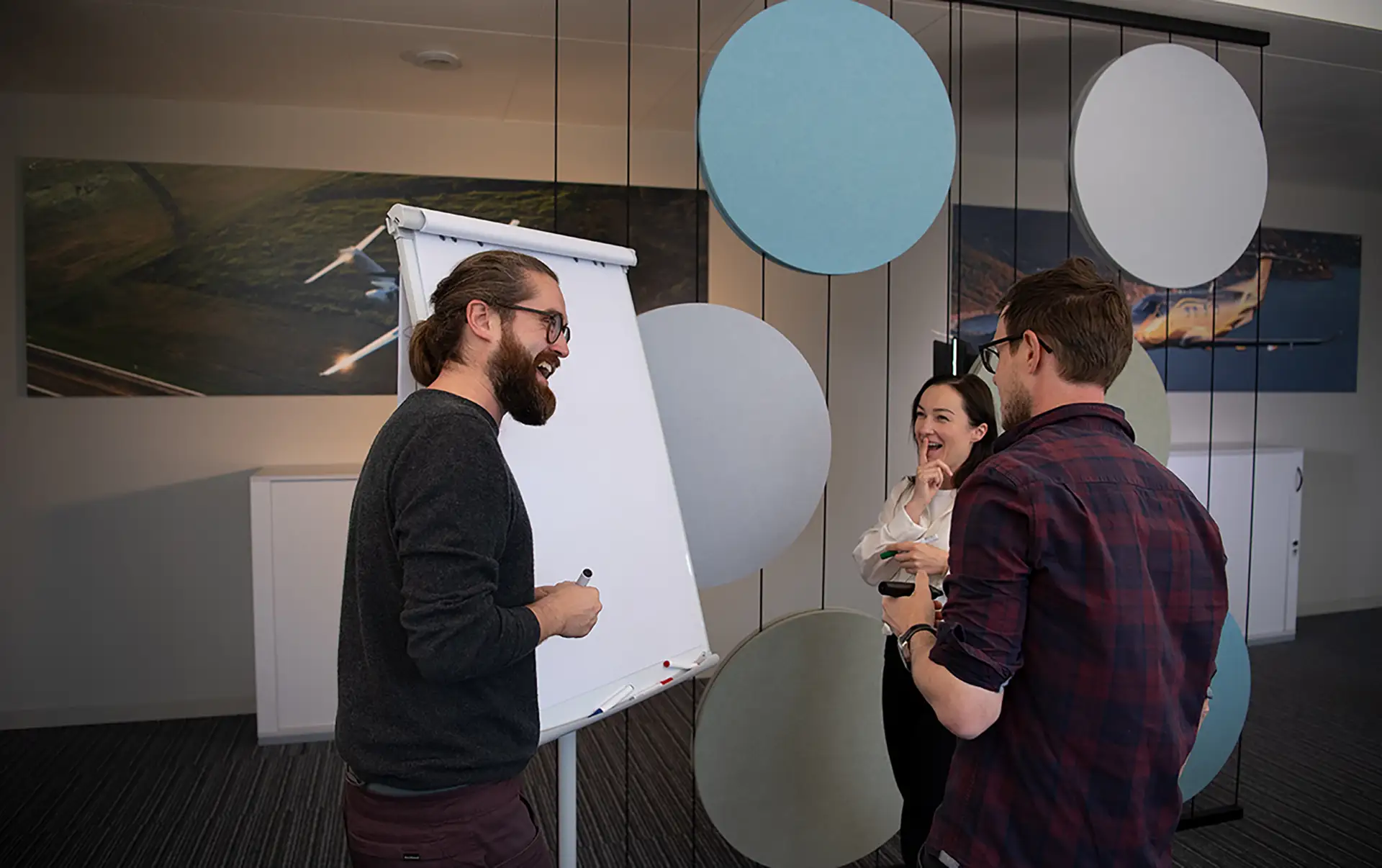Speed and agility: those are two of the outstanding features of the PC-24. And they are characteristics which are equally essential inside the company, too.
If you want to build the most innovative aircraft in the world, you need the most innovative development methods. At first glance, that would appear to be entirely logical and quite simple. Look again, however, and you will appreciate that an entire corporate culture has to change in order to keep up with the acceleration in digital transformation – and, most importantly, to stay ahead of the competition. Traditional top-down methods are are not the best way to maintain the pace of innovation. New approaches are required to achieve excellence and one thing in particular: agility.
Agility – A Concept That Has Already Been Embraced
Under Michael Matefi, the IT Software Development department implemented this principle more than three years ago and has now aligned all its processes around this concept. Software Development is responsible for developing digital IT solutions for internal and external stakeholders – making an important contribution to building the most innovative aircraft in their class with the help of state-of-the-art digital processes. Naturally, the leader still plays a crucial role within an agile team, but now tends to operate more as a “Servant Leader”. Rather than setting the pace and controlling – as in a classical management setting – the Servant Leader focuses on transmitting the visions and strategic direction within a product, and on providing method-related support. Pure development teams, as found up until a few years ago, no longer exist in the Software Development department. Instead, the teams are put together from all required disciplines, including internal and external Designers, Architects, Developers, Testers, Support Staff and Key Users. That kind of mix allows a so-called IT Product Team to handle all the work independently – from defininig initial specifications to the final IT product. We strive to create empowered teams, that is teams which are fully independent from start to finish. Most importantly, one must remain focused on the customer at all times and be guided by their evolving requirements. Whilst internal customers are part of the team from the outset, and accompany development processes from start to finish, the Product Manager, the Business Representative, plays a central role for external customers: he acts as “advocate for the customer”, communicating the latter’s preferences and requirements to the Development Team. “We have to be agile enough to react quickly to new requirements and offer innovative solutions which exceed our customers’ expectations”, says Michael Matefi.
Clear Structure Instead of Planlessness
Although it might not seem so at first glance: agility is anything but a haphazard chaos in which everyone proceeds with no plan at all. “On the contrary, a high degree of discipline and clear focus are key prerequisites”, stresses Michael Matefi. “As Servant Leader, my role is to assess exactly which skills and characters are required in the team and what is needed to ensure that people can work together in the best possible way”. Ultimately, the idea is to harness every individual’s creativity, know-how and passion so that the team as a whole can work iteratively towards the optimum solution. In addition, the teams constantly spur each other on to further improvements. They hold regular retrospectives, discuss how they work together, talk about what is going well or where there are problems – always with the aim of continuous improvement and increased efficiency. In Scrum methodology, the Eisenhower principle is applied to regularly assess the urgency and importance of tasks and define the next steps. That happens not only at daily standup meetings, which focus on day-to-day planning, but also at sprint planning meetings held every fortnight. Sprint planning is not simply about weighing up requirements or priorities, but also about defining the goals for the next sprint and setting the common focus.
A sprint consists of a number of small work packets, each one of which is planned and scheduled for a period of two weeks.
Agile Mindset as a Basis
The introduction of Agility requires not only a new approach as described above, but also far-reaching cultural change; a new way of thinking amongst our employees to inspire or at least empower them for the new path. The “Agile Manifest”, which encompasses four basic principles, provides an important basis:
individuals and interactions are more important than processes and tools
a functioning product/software is more important than comprehensive documentation
working with customers is more important than negotiating contracts
reacting to change is more important than adherence to a strict plan
In combination, these principles lead to a new and flexible mindset across the entire workforce.
Self-Organised Teams Across the Entire Company
In terms of agility, Michael Matefi emphasises that the Software Development department is by no means an insular entity within the company. “Various other teams, in Production for example, are similarly aligned and have already been using agile principles for some time now”. Which shows that constant questioning and prioritising of self-organised teams is already an important aspect of corporate culture at Pilatus. Michael Matefi is convinced that “cultural change is already well advanced, but we must continue with it and drive the concept of agility forward within the company in order to benefit from the full impact of this new approach”. We also want to channel our energy into new working methods, using agile methods to boost innovation, thus continuously reinforcing the company’s position as one of the global aviation industry’s undisputed drivers of innovation.
A Single Overall Digital Trace Instead of Parallel Systems
Perhaps the best example of agility at Pilatus is the Less Paper Platform (LPP). A central element of the digital workplace in aircraft assembly, it also has interfaces to various other systems and processes within the value chain. The term has been in use for some time already (e.g. in the context of the Electronical Production Instruction, EPI, introduced in 2015) but has become a rather meaningless generic term for various applications. Although focused on “Less Paper”, it did not have any platform character of its own, at least not until 2022.
The Big Change
A major change took place in 2022 with the development of a fundamentally new software architecture. The current platform, on which various projects were bundled, was created at the same time. These include the electronic audit trail (EAP), the open work list (EOWL) and the A-Inspection-List (EAIL) for internal quality optimisation. Instead of operating in parallel, the individual systems can now be used in combination to provide a single overall digital trace. New applications can benefit from this modern substructure and third-party applications can be better connected. New fixed development teams were created at the same time as these changes. Instead of working with numerous external software suppliers, Pilatus now works with just one, and thus with the same experts every time, who know the company inside out.

